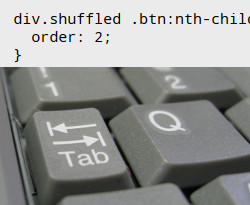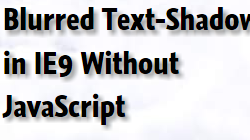 Firefox, unlike every other browser on the planet, changes the way that keyboard navigation works in designs that use the CSS
Firefox, unlike every other browser on the planet, changes the way that keyboard navigation works in designs that use the CSS order property. Since a lot of developers use flexbox, this can create a lot of cross-browser accessibility issues. This article shows a fix for this problem using a small amount of Javascript.
Flex Layout Fail: Fixing Firefox’s Keyboard Accessibility Bug With The CSS order Property
Tags: accessibility · CSS · flex-layout · order · Uncategorized
Augment Photos With CSS3 matrix3d() Transforms
 It’s possible to super-impose dynamic HTML content on top of a photos using 3D transforms to give the appearance that it is part of the picture. However, using a combination of
It’s possible to super-impose dynamic HTML content on top of a photos using 3D transforms to give the appearance that it is part of the picture. However, using a combination of translate3d(), scale3d() and rotate3d() functions to do this is difficult. This article discusses how to use the matrix3d() CSS transform with the Matrix Construction Set to get pixel-perfect 3D transforms easily and without any knowledge of matrix arithmetic. It also discusses the differences between matrix() and matrix3d(), as well as what fallbacks to use for browsers that don’t support transforms.
Tags: 3d · CSS · CSS3 · matrix · matrix3d · transform · transform3d · transform3d · Uncategorized
Fixing Cross-Browser Issues With CSS3 Viewport Units in IE9+ and Safari for iOS
 With viewport units, you can describe width, height, font-size and other CSS styles as percentages of the viewport width and height. There are, however, a few nasty gotchas when it comes to using them in iOS Safari and IE9 and 10. They also don’t always play nice in CSS3
With viewport units, you can describe width, height, font-size and other CSS styles as percentages of the viewport width and height. There are, however, a few nasty gotchas when it comes to using them in iOS Safari and IE9 and 10. They also don’t always play nice in CSS3 calc() statements and don’t work at all in IE Visual Filters. Using them in iframes can also be problematic. This post talks about how to work around these issues easily using a JavaScript buggyfill (not polyfill). I have used viewport units in production sites today, and now you can too, on any phone or device used in the wild today.
Tags: CSS · CSS3 · IE Visual Filters · math · viewport units
CSS Blurred Text-Shadow in IE — Part I
 Last week, I discussed several strategies web developers can use to simulate CSS text-shadow in IE. In that article, I mentioned that there was no way that I knew of to simulate text-shadow with a blur-radius in IE without JavaScript. Since then, I have discovered a way to simulate the CSS
Last week, I discussed several strategies web developers can use to simulate CSS text-shadow in IE. In that article, I mentioned that there was no way that I knew of to simulate text-shadow with a blur-radius in IE without JavaScript. Since then, I have discovered a way to simulate the CSS text-shadow effect in IE9 that does not use JavaScript and does not add extra elements to the DOM.
Tags: CSS3 · IE Visual Filters · text-shadow · Uncategorized
CSS3 Text-Shadow – Can It Be Done in IE Without JavaScript?
 CSS3
CSS3 text-shadow rocks, but it doesn’t work in any version of Internet Explorer, including IE9. While it is impossible to replicate all text-shadow effects in The Browser That Likes To Be Difficult, there are some ways to emulate this effect without JavaScript using Visual Filters, even when ClearType is enabled. This article can show you how and contains lots of examples.
Tags: ClearType · CSS3 · IE Visual Filters · text-shadow · Uncategorized
 @zoltandulac
@zoltandulac
 @zoltandulac
@zoltandulac Zoltan Hawryluk
Zoltan Hawryluk